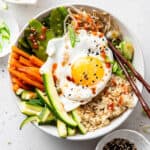A healthy spin on the Korean staple, this quinoa bibimbap is made with fluffy quinoa, steamed vegetables, and a fried egg for a flavorful alternative to takeout!
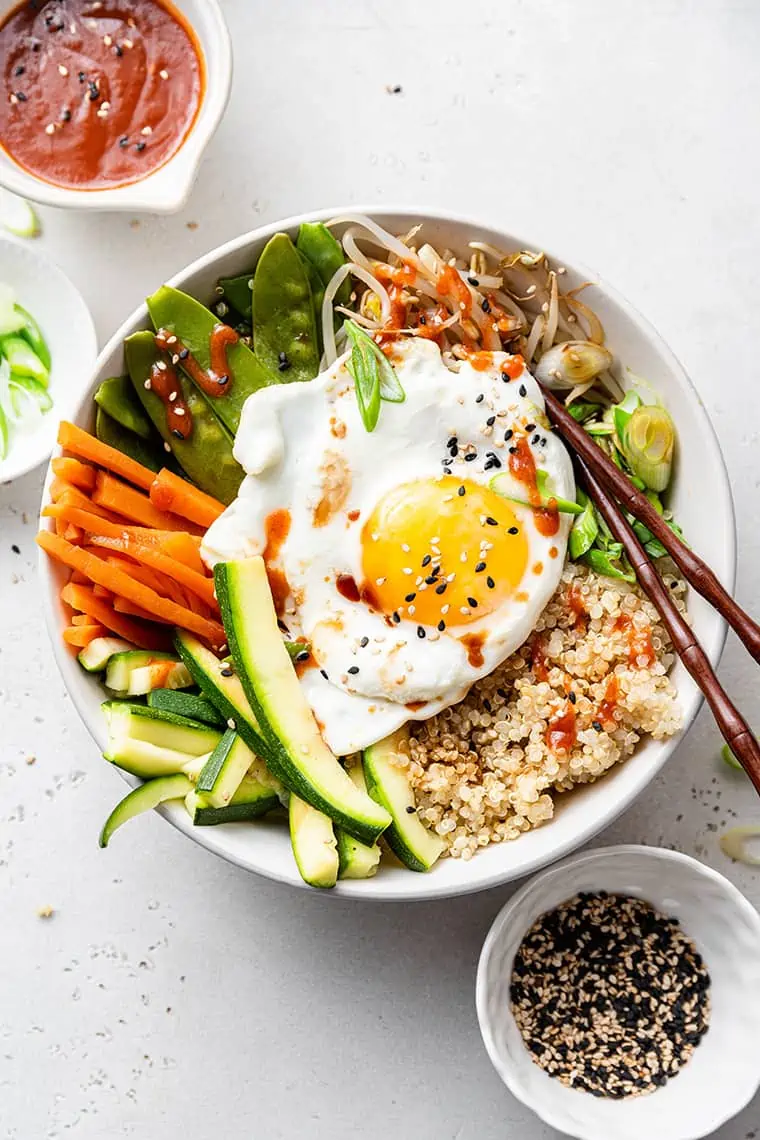
We love Asian-inspired dishes in our house and often order them for takeout, but what we love most is remaking these dishes into healthy, nutrient-dense meals—which is exactly where quinoa comes into play!
With rice being the primary grain used in most Asian cooking, I almost always swap the rice for more nutritious quinoa. So far we've made quinoa sushi, quinoa fried “rice”, and even quinoa stir fry.
Today we're remaking a classic Korean dish, bibimbap, using quinoa, steamed veggies, and a simple combination of sauces. For my version, I decided to keep things as light as possible and steam my veggies instead of sautéing them. By gently steaming the veggies, we're able to retain most of the nutrients while also making them easier to digest.
This quinoa bibimbap is protein-packed, super flavorful, and best of all, it can be whipped up in 15 minutes. Talk about the perfect weeknight meal!
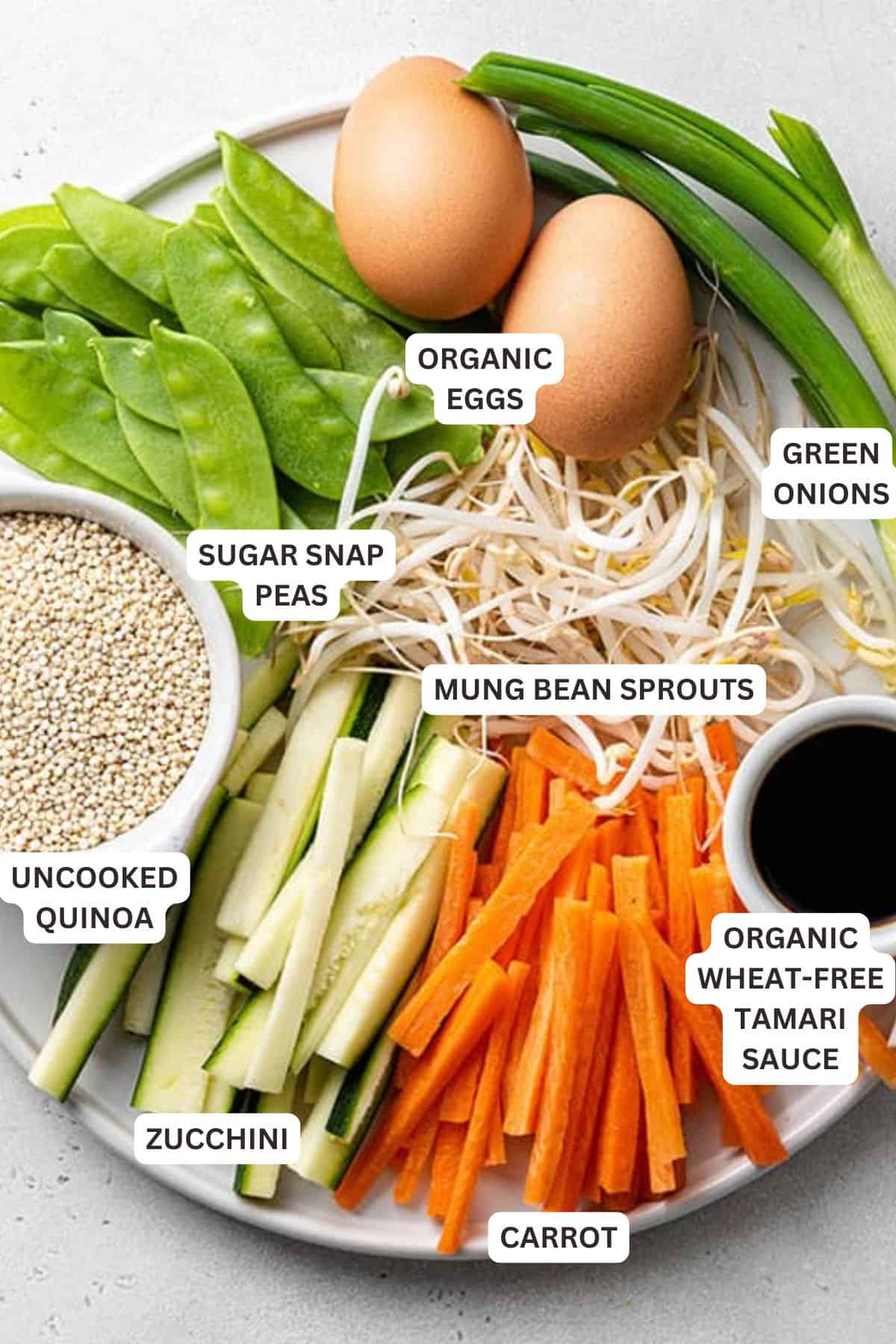
What Is Bibimbap?
Bibimbap originated in South Korea, but it has quickly risen in popularity around the world. In 2011 it was ranked 40th in CNN Travel's poll of the 50 most delicious foods. Traditionally, it’s made with rice, cooked vegetables, meat, raw or fried egg, then topped with namul or kimchi and gochujang, soy sauce, or doenjang.
What You’ll Need
Here’s what you’ll need to make this bibimbap at home:
- Uncooked quinoa
- Carrot – The carrot will need to be julienned, so you can buy it pre-cut to save yourself some prep time.
- Zucchini
- Sugar snap peas
- Mung bean sprouts
- Green onions
- Eggs
- Tamari sauce
- Sriracha – Or another hot sauce of your choosing.
What vegetables are in bibimbap?
My veggie blend was carrots, zucchini, and snow peas, but you can use whatever veggies you have in your fridge. Bell peppers, broccoli or cauliflower, and mushrooms would all be scrumptious!
Can you substitute sriracha for gochujang?
Yes, for this recipe, I’ve swapped in the more readily-available sriracha for the traditional gochujang to add heat. Of course, if you have gochujang on hand or if you can find it at your local grocery store, by all means, you can use that instead for a more authentic bibimbap!
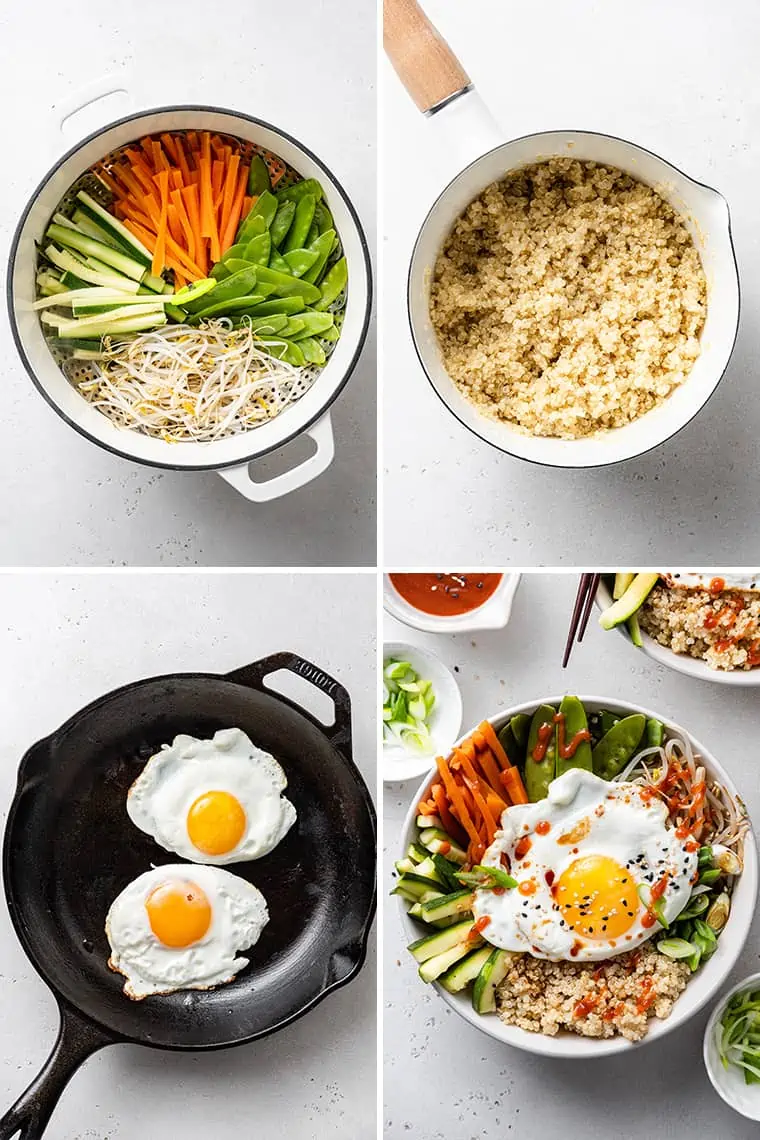
How to Make Vegetarian Quinoa Bibimbap
You’re 15 minutes away from a flavor-packed, healthy takeout remake! Here’s what you’ll need to do.
Cook the quinoa. Combine the dry quinoa and 1 cup of water in a saucepan and bring it to a boil. Cover and reduce the heat to low. Let the quinoa simmer for 8 to 10 minutes, or until all of the water is absorbed. Remove from the heat and let stand, still covered, for another 5 minutes.
Steam the vegetables. While the quinoa is cooking, place the carrots, zucchini, peas, and bean sprouts in a small steamer basket set over ½-inch of water in the bottom of a saucepan. Steam the vegetables for 3 to 5 minutes, or until they’re tender-crisp.
Cook the eggs. In a pre-heated frying pan, crack the eggs and cook them until they reach your desired level of doneness. For us, that was leaving them sunny-side-up and cooking them for about 4 minutes on one side.
Assemble. As the eggs are cooking, prepare your bibimbap bowls by dividing the quinoa into two bowls, then topping with the vegetables, tamari, and sriracha to taste. Top each bowl with the egg and green onions, then serve.
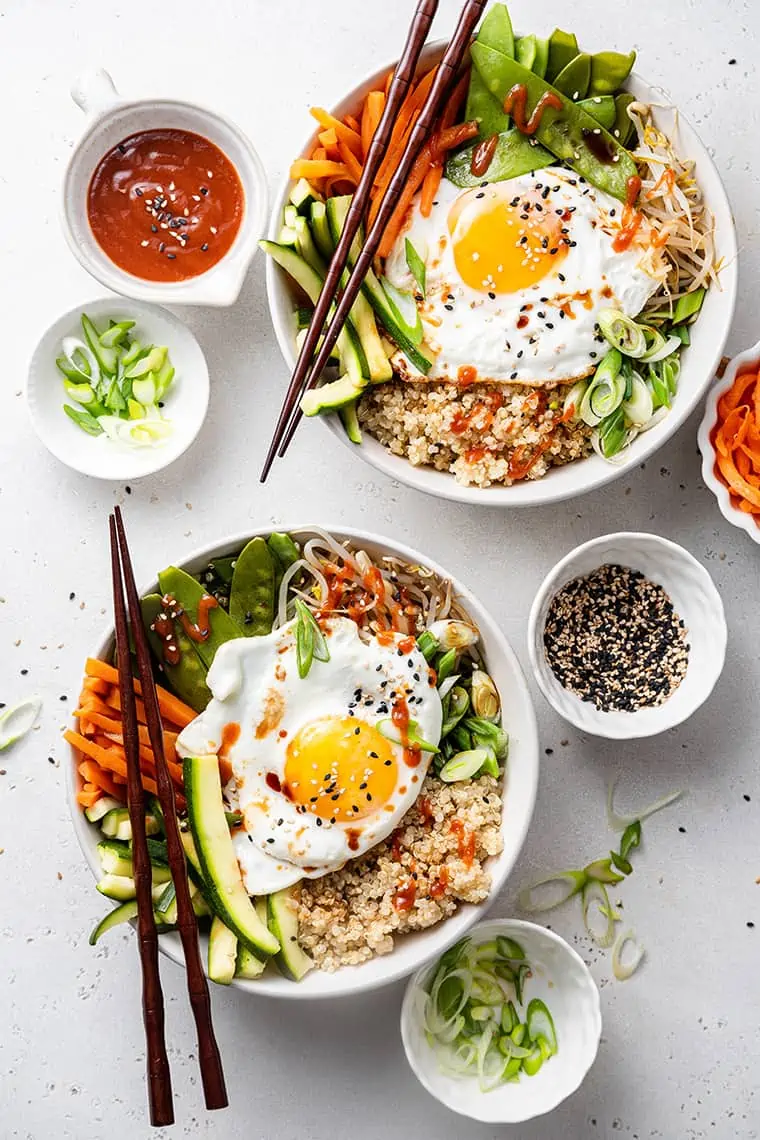
Tips for Success
Here are a few tips and pointers to help you make the perfect quinoa bibimbap.
- Rinse your quinoa. Unless your quinoa is pre-rinsed, you’ll need to rinse it well, as it has a bitter coating on the exterior called saponin.
- Adding more protein. Between the quinoa and the egg, this quinoa bibimbap has plenty of protein, but you can up the protein count even more by adding Crispy Baked Tofu or Firecracker Salmon.
- More garnish ideas. Serve your bibimbap with kimchi, Korean pickles, sesame seeds, a drizzle of sesame oil, nori strips, or lime wedges.
How to Store and Reheat Leftovers
This quinoa bibimbap is best eaten fresh because of the egg, but if you have leftovers, you can store them in an airtight container in the refrigerator for up to 2 days. Reheat in the microwave until warmed through.
Can This Recipe Be Frozen?
If you’d like to freeze this recipe, I recommend assembling it without the egg and adding that after you’ve reheated the veggies and quinoa. You can freeze the veggie and quinoa mixture for up to 2 months in an airtight container and microwave it until everything is warmed through.
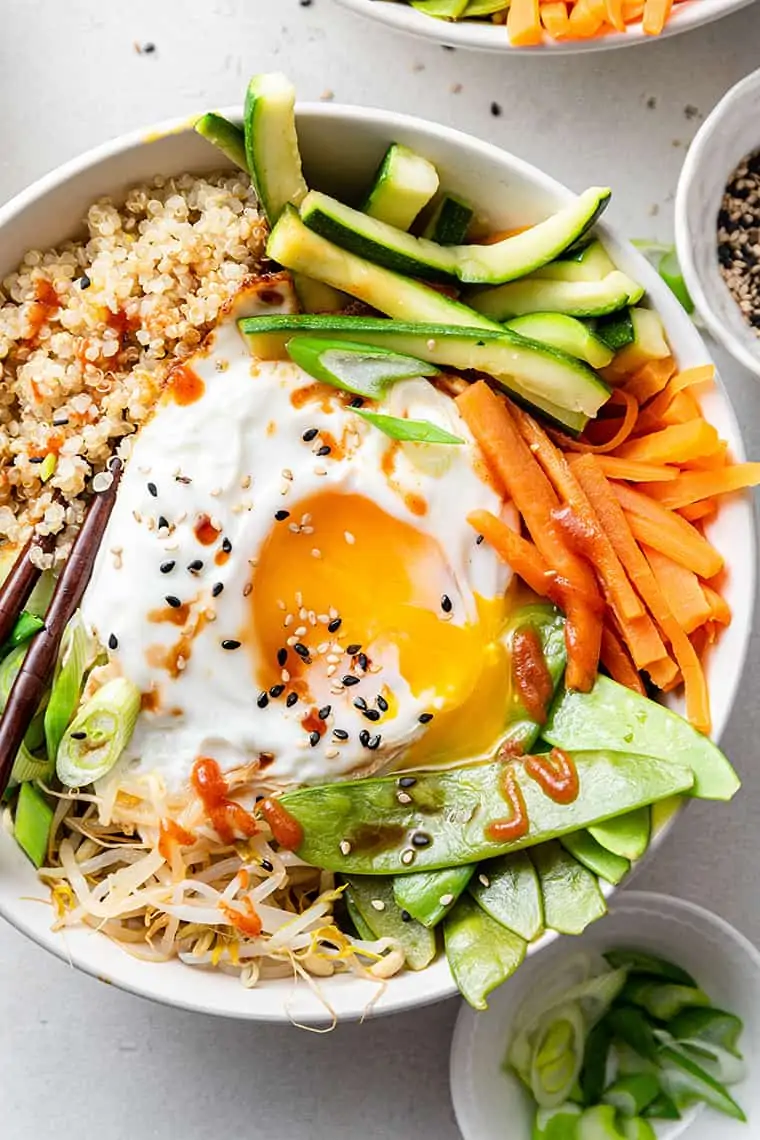
More Quick and Healthy Weeknight Meals:
- Sheet Pan Miso Roasted Vegetable & Cauliflower Rice Bowls
- One-Pot Spring Pesto Pasta with Peas & Asparagus
- Tofu & Broccoli Quinoa Stir-Fry
- 10-Minute Vegan Ginger Quinoa Bowl
- Balsamic Tempeh & Roasted Vegetable Quinoa Bowls
Korean Quinoa Bibimbap
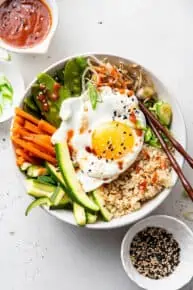
Ingredients
- 1/2 cup uncooked quinoa
- 1 medium carrot julienned
- 1 medium zucchini julienned
- 1/2 cup sugar snap peas ends removed
- 1/2 cup mung bean sprouts
- 2 green onions finely chopped
- 2 large organic eggs
- 1 tablespoon organic wheat-free tamari sauce
- Sriracha to taste or other hot sauce of your choosing
Instructions
- Prepare the quinoa by placing the dry quinoa and 1 cup of water on the stove to boil. Once the water reaches a boil, cover and turn down to low. Let the quinoa simmer for about 8 – 10 minutes, until all the water has been absorbed. Remove from the heat and let stand, still covered, for another 5 minutes.
- While the quinoa is cooking, prepare your vegetables. Add the carrots, zucchini, peas and bean sprouts into a small steamer basket ½” of water in the bottom of a sauce pot and steam for 3 – 5 minutes. You want the vegetables to be soft, but still firm.
- In a pre-heated frying pan, crack the eggs and cook until desired consistency. For us, that was leaving them sunny-side-up, cooking for about 4 minutes on one side.
- As the eggs are finishing to cook, prepare your Bibimbap bowl. Add half of the quinoa into the bottom of one bowl, top with vegetables, half of the tamari and a touch of Sriracha. Top with the egg and green onions, and voila, you have a delicious Korean dish on your hands!
- Serve warm and enjoy, with a touch more heat if your pallet can handle it.
